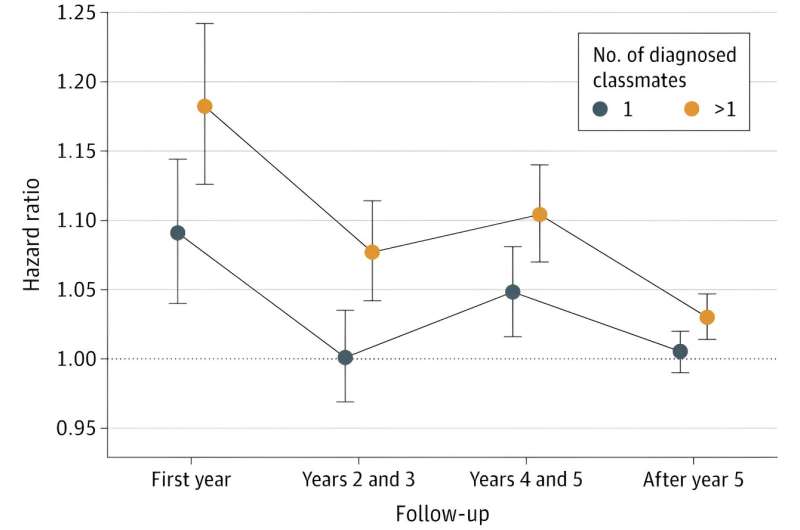This article has been reviewed according to Science X's editorial process and policies. Editors have highlighted the following attributes while ensuring the content's credibility:
fact-checked
peer-reviewed publication
trusted source
proofread
Mental disorders may spread in young people's social networks

Using population-wide registry data, researchers from the University of Helsinki, the Finnish Institute for Health and Welfare, the University of Jyväskylä and the University of Manchester investigated whether mental disorders can be transmitted within social networks formed by school classes.
The study, published in JAMA Psychiatry, is the largest and most comprehensive so far on the spread of mental disorders in social networks, with more than 700,000 ninth-grade pupils from 860 Finnish schools participating. The adolescents were followed from the end of ninth grade for a median of 11 years.
The researchers demonstrated that the number of classmates diagnosed with a mental disorder was associated with a higher risk of receiving a mental disorder diagnosis later in life.
"The observed link was the strongest during the first year of follow-up in the study. This was not explained by a number of factors related to parents, school and residential area. The link was most pronounced in the case of mood, anxiety and eating disorders," says Associate Professor Christian Hakulinen of the University of Helsinki.
Research enabled by comprehensive Finnish registers
According to Hakulinen, prior studies have yielded similar results: For example, American researchers have observed indications of depressive symptoms potentially being transmitted from one individual to another in social networks.
In prior research, however, social networks have typically been chosen independently by the research subjects, which may result in bias in the data. Hakulinen points out that school classes are social networks well suited to research, as people are usually not able to choose their classmates.
"Defining the social networks and following adolescents were made possible by extensive Finnish registers. The findings significantly deepen our understanding of how mental health problems develop and affect other people in our social networks," he says.
Hakulinen nevertheless notes that the connection observed in the study is not necessarily causal. Furthermore, the study did not investigate how mental disorders can potentially be transmitted between individuals.
"It may be possible, for instance, that the threshold for seeking help for mental health issues is lowered when there are one or more people in your social network who have already sought help for their problems. In fact, this kind of normalization of diagnosis and treatment can be considered beneficial contagion of mental disorders," Hakulinen says.
More preventive measures?
Mental disorders are a significant global challenge, adversely affecting individuals, society and the economy. According to Hakulinen, anxiety and mood symptoms in particular have in recent years increased among young people.
Previous studies have shown that, in roughly half of all cases, the onset of mental disorders in adulthood occurs when people are under 18. In fact, Hakulinen emphasizes the importance of preventive measures and early intervention.
"When taking preventive measures, it's worthwhile considering that mental disorders can spread from one adolescent to another," Hakulinen says.
The study involved a total of 713,809 Finnish citizens born between 1985 and 1997. The adolescents were investigated from the end of comprehensive school until they received their first mental disorder diagnosis, relocated from the country or died. At the latest, the follow-up was discontinued at the end of 2019, resulting in a median follow-up period of 11.4 years.
More information: Jussi Alho et al, Transmission of Mental Disorders in Adolescent Peer Networks, JAMA Psychiatry (2024). DOI: 10.1001/jamapsychiatry.2024.1126




















